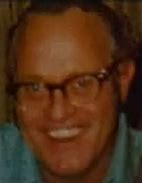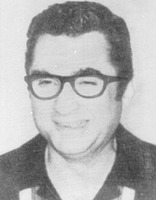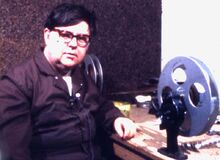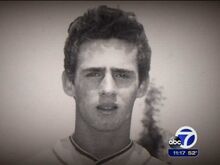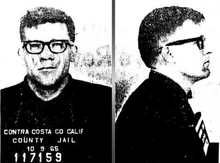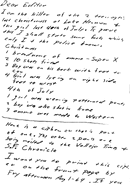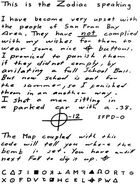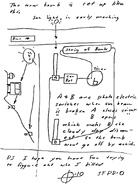| “ | I like killing people because it is so much fun. | ” |
— The Zodiac Killer
| ||
The Zodiac Killer also referred to as The Zodiac or simply Zodiac was an enigmatic serial killer active in California in the late 1960s and 1970s. As infamous as he was, he only has a confirmed body count of five, though he is suspected of committing as many as thirty-seven murders in total.
Case History
First attacks and letters
The first known confirmed Zodiac murders took place on December 20, 1968, on Lake Herman Road in California. The victims were David Arthur Faraday, 17, and Betty Lou Jensen, 16, both of which were shot with a .22 handgun. The Zodiac then remained inactive until July 4 the following year, when he shot another couple, Michael Mageau, 19, and Darlene Ferrin, 22, while they were seated in a parked car on the parking lot of the Blue Rock Springs Park in Vallejo. Mageau survived, though he suffered severe injuries, and was able to provide a description. On August 1, the Vallejo Times-Chronicle, the San Francisco Examiner and the San Francisco Chronicle received near-identical letters from the Zodiac in which he took credit for the murders, proving his guilt by stating several facts about the crime scenes, such as what the victims were wearing, how their bodies were positioned and what brand of ammunition he used. The only signature was the Zodiac's symbol. The letters also contained one part of a three-part cipher designed by the Zodiac, who ordered all three papers to publish the ciphers on their front pages and threatened to go on a killing spree over the weekend if they didn't comply. All three papers published the cipher, which was cracked after a little more than a week by teachers Donald and Betty Harden. In the decoded message, the Zodiac claimed to have been killing in order to collect slaves for his afterlife. The next Zodiac letter came the day before the cipher was cracked. In it, the Zodiac named himself for the first time and gave more details about the murders.
Later murders
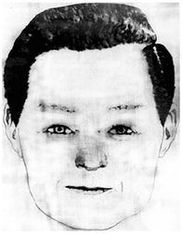
A sketch depicting an unknown man reportedly seen at Lake Berryessa, on the day of the Shepard-Hartnell attack
The next murder took place near Lake Berryessa on September 27. This time, the victims, Bryan Hartnell, 20, and Cecelia Shepard, 22, were tied up and stabbed instead of shot. Hartnell survived his injuries, but Shepard died two days later. During his next killing, the Zodiac diverged from his pattern even further and shot and killed a cab driver, Paul Lee Stine, 29, in Presidio Heights in San Francisco on October 11 after riding with him. This time, a partial fingerprint in blood was found inside the car, along with a pair of gloves (which were, however, considered to be too small to fit the man described by the witnesses. They were later linked to a female passenger of Stine). At first, the police were led to believe that the killer was black, which was later corrected. Before that, however, a pair of uniformed cops on their way to the crime scene spotted a man fitting the Zodiac's description dressed in a dark jacket and walking away from the crime scene mere minutes after the shooting. Three days later, the San Francisco Chronicle received a letter in which the Zodiac threatened to kill all the passengers of a school bus and included a piece of Paul Stine's bloody shirt. Though this was the last of the Zodiac's confirmed killings, he continued writing letters and claimed responsibility for several murders during this time. It is generally believed that he lied for attention. One theory suggested in the Monster: The Zodiac Killer podcast is that other contemporary events got a lot of media attention, such as the Manson Family murders and The Vietnam War, and the Zodiac kept writing letters in an effort to stay in the public consciousness.
The prime suspect in the case, at least in the eyes of the public, was and remains Arthur Leigh Allen. The authorities began investigating him after they were told by one of his former friends, Donald Cheney, that Allen had told him about an idea he had for a novel about a serial killer who called himself "Zodiac" and did several things the Zodiac Killer did or threatened to do, such as taping a flashlight to his gun and killing the passengers of a school bus. In hindsight, Cheney's story has been viewed with a lot of skepticism, in part because Allen was accused of molesting one of Cheney's sons, but also because his account of when Allen supposedly told him has shifted over the years and sometimes added details not present in the first telling; for example, after the abduction of Kathleen Johns, Cheney also started saying that Allen had talked about tricking women into thinking their tires were coming off and using that as an excuse to loosen them, like what happened to Johns. Also worth noting is that Cheney and Allen's situation isn't unique and there were other people at the time who made similar claims about people they knew. Allen was however a skin diver who had been to Lake Berryessa on several occasions. He also admitted to having had bloody knives in his car on the weekend of the stabbing but claimed that the blood came from a chicken he had killed for dinner. After a warrant for his trailer and handwriting was secured and carried out, his fingerprints were compared to the partial from the cab, his guns compared to the Zodiac evidence and his handwriting to that of the letters. None of the tests came back a match and Allen was let go. In 1991, Mageau was tracked down and shown a lineup of old photos of Zodiac suspects. After he fingered Allen as the killer, there were talks about formally charging him with the murders based on circumstantial evidence against him (which were, in turn, heavily contested by others). Allen died of natural causes before any trial could take place. To this day the case remains unsolved and the Zodiac killer's identity is still unknown.
Letters
For images, see below
The Zodiac is known to have sent many cryptographic, taunting and puzzling letters to the authorities, the press and famed lawyer Melvin Belli. In these letters, the Zodiac made his intentions and wishes known, as well as, allegedly, his state of mind. In some, he would include odd drawings, mosaics of photos, and astrological charts. The first letters included a cipher which, he claimed, hid his identity. It eventually revealed a disturbing piece where he clarified his motivations, but it didn't include anything that could be identified as a name. Below are some of the letters The Zodiac sent to the SFPD and the local newspapers. To date, almost none of his ciphers have been definitively solved. The exceptions are the initial 408 character cipher, which was solved not long after the newspapers received it by Donald Harden, a high school history teacher in Salinas, and his wife Bettye Harden, and the so-called 340 Cipher, which was solved in 2020 by David Oranchak, an American software engineer, Sam Blake, an Australian mathematician, and Jarl Van Eycke, a Belgian computer programmer.
Modus Operandi
From the accounts of the few survivors of known Zodiac attacks, it is generally believed that the Zodiac dressed in black clothing of various types (depending on the month), and, at least on one occasion, wore a dark hood decorated with the Zodiac symbol.
His methods varied also, with some victims being dispatched by an automatic pistol (of several types) or bladed weapons, most notably what was probably a military-style knife. According to one of his letters, he, during the Christmas killings, had a pencil-sized flashlight taped to his gun in order to be able to shoot in the dark.
The Zodiac's usual pattern of attack was to target Caucasian teenage couples, strike when they were in some secluded area (mostly lover's lanes) and/or in a car and kill them by either shooting them or stabbing them with a knife. His method of approaching them is known to have varied. When he attacked Mageau and Ferrin, he just walked up to the car and started shooting at them without saying a word, while, during the Hartnell-Shepherd stabbing, he approached them pretending to be a robber before instructing Shepherd to tie up Hartnell with some pre-cut lengths of rope and then tying her up himself. During the latter killing, he claimed to be an escaped convict who had killed a guard and needed their car and money so he could flee to Mexico. When he killed Paul Stine, he got into his taxi, shot him in the head with a 9mm, took his wallet, car keys, and a bloodied piece of his shirt, the latter of which he would later send to The Chronicle. He also, most likely intentionally, acted in locations were jurisdictions overlapped, as a mean of slowing down the authorities. In one of his letters, he claimed to have killed some of his victims "by fire" and "by rope". Though cases involving strangulation were linked to the Zodiac (the Santa Rosa hitchhiker murders), no cases involving arson were ever linked to him.
After the Ferrin-Mageau and Hartnell-Shepard attacks, he called whichever police department was closest to where the attacks occurred from a pay phone and claimed responsibility for the crimes.
Profile
The Zodiac Killer was profiled by John Douglas in his book, The Cases That Haunt Us, as being a narcissistic and paranoid social misfit and loner, who was mainly driven by the need for attention, power and, most of all, credibility. He felt the urge to prove his intellectual superiority, in order to compensate his own feelings of inferiority and inadequacy. The UNSUB had also a self-conscious compulsiveness, meaning that he was obsessed with others underestimating him and unappreciating his skills, being also convinced that society wronged him. In all likelihood, he spent the majority of his life with his mother, with whom he had a difficult relationship at best, and was not very successful with women. It was deemed probable that he had some relations with both Riverside College (where Cheri Jo Bates, a suspected Zodiac victim, was killed. Douglas was indeed fairly sure to attribute this murder to him) and Deer Lodge, Montana (the location of the prison he allegedly named during the Hartnell-Shepard attack. However, the validity of this claim is doubtful, as the prison name was merely deduced by a policeman who interrogated survivor Bryan Hartnell).
He may have spent some time in the military, probably in the Air Force or the Navy, where he was likely trained in codes. If this be the case, he would have been soon discharged out of medical reasons or no reasons given, because he couldn't cut in such a structured, disciplined environment long-term. He liked and was familiar with weapons, being probably a hunter, and had technical expertise, demonstrating skill with numbers and codes. The UNSUB also might have had a private work area, where he kept the materials he needed for his writings and press coverage of his crimes. He probably complained, with a confidant of some kind (most likely another loner), about law enforcement demonstrating incapacity in the Zodiac case.
In his letters, as in his crimes, the offender displayed a double nature: well-educated and highly intelligent, although illiterate, and highly organized, although, at least in some instances, disorganized (he left survivors, fingerprints and was seen by several witnesses, including two policemen). This combination provides a mixed representation. It is also apparent, from his communications, that the Zodiac was prone to mood swings: sometimes being cleverly taunting, sometimes falling from grace, trying to compensate his fear and inferiority complex through virulent words or gross tauntings.
It was deemed likely by Douglas that, as the Zodiac was constantly trying to sophisticate himself and his Modus Operandi, the most probable cause for his sudden stop was his own fear of running out of luck, after having been presumably spotted and interrogated by two uniformed patrolmen, just minutes after the murder of Paul Stine. It cannot be excluded, also, that the Zodiac committed suicide after the murders ended.
Murray Miron, a criminologist and colleague of Douglas, upon analyzing the letter Zodiac sent to Melvin Belli on December 1969, concluded that the UNSUB was suffering from severe depression, and that he was going to eventually commit suicide. Douglas, in turn, although convinced that the Zodiac did feel even more alone and alienated around Christmas time, and agreeing with the fact that he would have committed suicide one day, thought the letter was a play for sympathy.
A theory, proposed by Anglo-Canadian criminologist Lee Mellor (proponent of the expressive/transformative violence theory), was that the Zodiac, by sending letters and leaving messages on the crime scenes, was dealing with a process of identity negotiation. Due to his feelings of inadequacy, he wasn't capable of having an acceptable identity and suffered from recurring crisis, trying to recompose his fragmented identity in the guise of a self-styled, self-named killer. The majority of the expressive/transformative criminals analyzed by Mellor was single, sustained having never grown up, presented an unstable vocation and masculinity, and were obsessed with police and military culture.
Criminologist Donald Lunde theorized the Zodiac was a sexual sadist whom killed as a substitute of sex.
Physical Description
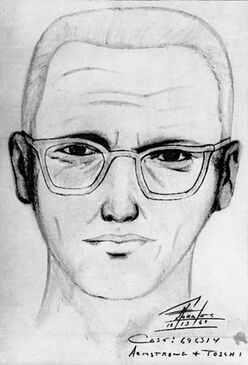
Sketch of the Zodiac based on witness reports.
Survivors and witnesses of the Zodiac attacks described him as:
- Approximately 5' 8" to 5' 10" in height.
- Curly brown or light reddish brown hair worn in a crew cut.
- Wearing horn-rimmed eyeglasses and usually wore dark clothing, usually wool trousers and dark navy blue or black windbreaker jacket, with distinctive military jump boots known as "Wing Walkers".
- Medium or slightly stocky build.
- One survivor describes the Zodiac as having an odd gait; that is, he had a peculiar, lumbering or heavy walk.
- Boot prints found at the Hartnell-Shepherd crime scene were size 10½.
- Survivor Bryan Hartnell describes the Zodiac's voice as "Slow and measured" and having a unique sound and cadence with a monotone.
Suspects
- Arthur Leigh Allen (1933-1992)

Arthur Leigh Allen, the prime suspect.
- Dishonorably discharged from the U.S. Navy.
- Elementary school teacher and janitor.
- Lifeguard.
- Sail maker.
- High I.Q.
- Was allegedly in Riverside when Cheri Jo Bates was murdered.
- Thought to be the "Lee" Linda Ferrin, Darlene Ferrin's sister, referred to as "best friend with Darlene".
- Admitted to having had bloody knives in his car on the weekend of the Zodiac's stabbing at Lake Berryessa, but claimed that the blood came from a chicken he had killed for dinner.
- Was taller and larger than the description of the perpetrator of the Mageau-Ferrin shooter and was balding at the time, which the perpetrator was not described as being.
- Was in jail for child molestation during the time of the alleged Zodiac's 1971-74 hiatus. However, some suggested Zodiac's hiatus to have started well before Allen was incarcerated.
- Named "Robert Hall Starr" in Graysmith's non-fiction book Zodiac.
- Still generally considered the prime suspect in the case in the eyes of the public, in no small part due to Graysmith's book and the movie adaptation.
- His guns, fingerprint, and handwriting were all compared to the case evidence, but he was cleared. Also, in 2002 a DNA comparison was made between a stamp from a Zodiac letter and Allen's DNA and came back negative, though Allen had stated that he never licked his stamps because the glue made him feel sick.
- In 1991, survivor Michael Mageau pointed him out when shown a set of Zodiac suspect photos from the time of the killings. Mageau's identification was, in turn, deemed inconsistent by the authorities.
- Robert Graysmith's case against Allen in his books, Zodiac and Zodiac Unmasked (and, by extension, the inspired David Fincher's film of the same name as the first book), was heavily criticized and/or contradicted by facts and both people involved in the investigations and Zodiac Killer scholars. Graysmith himself was accused of having mixed facts and fiction (or unverified and contradictory circumstancial evidence) in order to sustain his theory that Allen was the culprit. To this day, only Allen's claim of having a bloody knife in his car, on the day of the Lake Berryessa attack, is considered a possible link, among few others, to him being the Zodiac.
- On 3/13/1971, Arthur Leigh Allen was pulled over by police for a traffic violation in San Francisco. That same day, 3/13/1971 a Zodiac Letter was mailed, not from San Francisco but from Pleasanton, CA and not to the Chronicle but to the LA Times. This would be the first and last from these locations. Pleasanton, CA is about an hour away from San Francisco.
- Jack Tarrance (1928-2006)

Jack Tarrance
- Honorably discharged from the U.S. Air Force and Navy.
- Ham radio operator.
- Steel company worker.
- General Electric test foreman.
- Laundry Attendant.
- Was reported by his stepson, Dennis Kaufman.
- Kaufman turned over several pieces of evidence, including:
- A hood similar to the one described by one of the Berryessa victims.
- Handwriting samples.
- Undeveloped photo film reels, one of which contained gruesome images.
- A knife covered with dried blood.
- A taped phone conversation in which Tarrance may indirectly hint that he was the Zodiac.
- DNA testing by the FBI proved inconclusive.
- Lawrence "Larry" Kane (1924-2010)

Lawrence "Larry" Kane
- Matched the Zodiac description, although approximately.
- Strongly attached to his mother.
- U.S. Navy sailor.
- Attended Navy's Radio Materiel School, where he trained in enciphering and deciphering Navy codes.
- Worked various white collar jobs.
- Known as a peeping tom, prowler and con artist. Was arrested for these and other crimes.
- Suffered an accident in 1962 which, according to medical reports, compromised his "control of self gratification".
- Lived in the vicinity of the spot where, approximately, Zodiac was picked up by Paul Stine on the night he was shot.
- Lived and worked in South Lake Tahoe, from where a suspected Zodiac victim, Donna Lass, disappeared. He also worked in the vicinity of Lass' workplace. Co-workers said Kane and Lass knew each other.
- Identified by Darlene Ferrin's sisters, Pam and Linda, as the man whom harassed Darlene before her murder. However, both identified several other people before Kane (George Waters, a man known as "Lee" and William Grant), so their claims are deemed doubtful.
- Identified, although not with absolute certainty, by one of the policemen who presumably spotted to the Zodiac minutes after the murder of Paul Stine.
- Also identified by Kathleen Johns, a suspected Zodiac victim, as the man who abducted her and her daughter.
- Retired Vallejo Detective Ed Rust believes Kane to be the killer, as well as Donna Lass being one of his victims.
- Identified by Donna Lass' friend, Larry Lowe, as having being interested in astrology.
- Described by people around him (including his friend John Miles) as "an egotist".
- Diagnosed in 1943 with "psychoneurosis hysteria".
- His name (plus the space between his first and last name) would fit the 13 unsolved characters in the Zodiac's "my name is" letter.
- Bruce Davis (1942-Present)

Bruce Davis
- Former Manson Family member.
- Was cleared along with other members of the "Family" briefly suspected to be behind the murders.
- Richard "Rick" Marshall (1928-2008)

Richard "Rick" Marshall
- According to some acquaintances, lived in Riverside at the time of Cheri Jo Bates' murder.
- U.S. Navy sailor.
- Had code training.
- Silent movie theater projectionist.
- Movie buff.
- Ham radio enthusiast.
- Was known to have had a bad temper with women.
- Named "Donald Jeff Andrews" in Graysmith's non-fiction book Zodiac.
- Louie Myers (1951-2002)

Louie Myers
- Admitted on deathbed to being the Zodiac Killer.
- Went to the same high schools as the first confirmed male and female victims.
- Worked at the same building as the second female victim.
- Had access to the type of military boots the Zodiac is known to have worn through his father's job.
- Served in the U.S. Army.
- Worked as a long haul truck driver.
- Had a criminal record in Vallejo for petty, unrelated crimes such as theft and disorderly conduct.
- Was stationed at a military base in Germany during the Zodiac's alleged hiatus.
- Did not fit the description of the Zodiac given by witnesses.
- Earl Van Best, Jr. (c. 1936-1984)

Earl Van Best, Jr
- Named as a suspect by his son, Gary L. Stewart, in his book, The Most Dangerous Animal of All, in 2014.
- Stewart claimed that Best's name and usual signature, E. V. Best Jr. could be found in the Zodiac's untranslated ciphers; however, his method for finding them, finding a single letter per line and putting them together, can be used to find a lot of names in the cipher, making this suggested intention very improbable.
- Stewart hired a handwriting expert, Mike Wakshull, who went on to write his own book about his involvement in the case called The End of the Zodiac Mystery. Wakshull claimed that handwriting samples from documents obtained from a certain church that were supposedly written by Best matched the handwriting in the Zodiac's letters. However, when a Zodiac theorist contacted this church and asked about this, it turned out that the documents had actually been written by the church's reverend and that the handwriting samples Wakshull based his conclusion on came from a total of three different people's writing.
- His relationship to his underage wife was covered in a series of articles written by Paul Avery, a journalist who covered the Zodiac case while working for the San Francisco Chronicle and got a personal threat from him in the mail.
- Rare book dealer.
- Was convicted of raping a minor and document and wire fraud and incarcerated for years in a maximum-security facility for the criminally insane and San Quentin.
- Similar to the Zodiac's physical description.
- Was dismissed as a suspect as he was travelling through Europe at the height of the Zodiac's killing spree.
- Richard Gaikowski (1936-2004)

Richard Gaikowski
- Matched, approximately, the Zodiac description.
- Served in the U.S. Army
- Worked as an Investigative reporter for a Contra Costa newspaper. Also worked for a rival newspaper to the one Darlene Ferrin's husband worked for, in Albany, NY, while both Gaikowski and Darlene lived there.
- Known as a film buff, drug user and anti-police activist.
- Gaikowski had the habit of shortening his last name to four letters and use multiple spellings, such as "Gike" or "Gaik". The word "GYKE" can clearly be seen in Zodiac's three-part cipher mailed on July 31, 1969.
- An establishment of the counterculture newspaper he worked for, The Good Times, was located near the Paul Stine murder scene. Also, his cousin lived near the scene.
- Paul Stine's sister recognized Gaikowski as having attended her brother's funeral. Neither Gaikowski nor Paul knew each other.
- Was diagnosed with a mental illness shortly before the Zodiac alleged hiatus. When the Zodiac reemerged he was operating a storefront theater in San Francisco.
- Nancy Slover, the police dispatcher who spoke with the Zodiac in July 1969, identified Gaikowski's voice as being the same as the Zodiac's voice.
- In 1986, the Napa County Sheriff's Dept. briefly investigated Gaikowski. Meanwhile, the California Dept. Of Justice determined that Gaikowski's handwriting had consistencies with Zodiac's handwriting and more samples of Gaikowski's printing were requested. Those samples were determined to not be a match.
- Considered as the prime suspect by Zodiac Killer scholar Tom Voight.
- Was dismissed as a suspect as he was reportedly to be in Northern Ireland, covering the events of The Troubles.
- Gaikowski's passport application listed his departure date for Northern Ireland as the 1st November 1968.
- George Waters
- One of the men identified as Darlene Ferrin's harasser.
- Cleared as a suspect by the Vallejo police in 1969.
- Michael O'Hare
- Public policy professor at the University of California, Berkeley
- Was accused of being the Zodiac Killer by Gareth Penn, a true crime author and amateur detective, starting around 1981 in amateur newsletters and self-published books.
- William Grant
- One of the men identified as Darlene Ferrin's harasser.
- Ross Sullivan
- Library assistant at Riverside City College, attended by possible Zodiac victim Cheri Jo Bates. His coworkers suspected him of the murder, noting that he had gone missing for several days after it happened.
- Hospitalized multiple times for bipolar disorder and schizophrenia.
- Resembled the sketch of the Zodiac's face.
- Wore military-style boots with footprints similar to the ones the Zodiac had left behind at the Lake Berryessa crime scene.
- Giuseppe Bevilacqua (1935-2022)
- Known as Joseph Bevilacqua.
- Named as a suspect by Italian free-lance journalist, Francesco Amicone in articles for in Italian magazine, Tempi and newspapers, Il Giornale and Libero in 2017.
- Served in the army.
- Immigrated to Italy after leaving the army in 1974, soon after the last letter was sent.
- Guy Ward Hendrickson
- Carpenter
- Lived in Santa Ana during the 60's and 70's
- Accused by his daughter, Deborah Perez, of having been the Zodiac. She claimed that he had taken her along for some of the killings, with her thinking they were just regular trips, and that she helped write some of the letters and ciphers. These claims were heavily contested by Hendrickson's daughter from a prior marriage.
- Perez also presented a pair of glasses she said the Zodiac had taken from Paul Stine and which had been found among her father's possessions, but the SFPD examined them and determined they weren't Stine's.
- Gary Francis Poste (1937-2018)
- Air Force Veteran
- Shared several identifying marks along with the Zodiac including forehead and the same shoe size.
- According to a male witness, he claimed to have seen Poste burying items believed to be the murder weapons used by the Zodiac in the woods.
- It is believed by some witnesses, including that of Poste's daughter-in-law, that he didn't work alone, but was the ringleader of a posse of assassins.
- Several anagrams sent to the San Francisco Chronicle were believed to have contained Poste's name.
- Notes:
- Serial bomber Theodore Kaczynski, the Unabomber, was briefly considered a suspect for being the Zodiac Killer since he lived in the San Francisco Bay Area between 1967 and 1969, the period of the Zodiac's confirmed killings, while he was teaching geometry and calculus at the University of California, Berkeley. He was investigated as a suspect in 1996, but was ruled out by the FBI and the SFPD in part by fingerprint and handwriting comparisons, but also because he had been outside of California on known key dates related to the Zodiac.
- David Carpenter, a serial killer in his own right, was also considered a suspect, but had been in jail during the first confirmed killing and was cleared in handwriting and fingerprint comparisons.
- Edward Edwards, also a serial killer, was allegedly assumed to have matched the Zodiac's physical description, although he was living in northern California during the murders, and these allegations have been disputed.
- Zodiac suspect, Giuseppe Bevilacqua is suspected of being the Italian serial killer known as The Monster of Florence who was responsible for 14 murders between the 21st August 1968 and the 8th September 1985. In the timeframe between the Zodiac and The Monster of Florence killing sprees, Bevilacqua was stationed in Italy at the time of the murders of The Monster's first two victims, Antonio Lo Bianco and Barbara Locci. After the Lo Bianco and Locci murders, Bevilacqua was stationed in the US around the time of the Zodiac's killing spree. After the last letter was sent by the Zodiac in January 1974, Bevilacqua left the army and moved back to Italy, shortly before The Monster of Florence had restarted his killing spree.
Known Victims

The Zodiac's fatal victims.
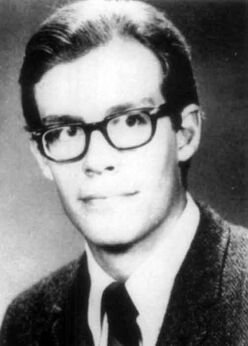
Survivor Bryan Hartnell.
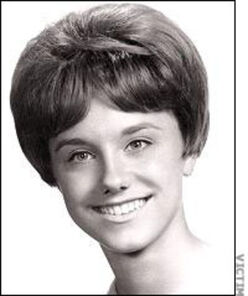
Cheri Jo Bates, a possible Zodiac victim.
Confirmed
All of the following were killed in California
- December 20, 1968, Lake Herman Road, Vallejo: David Faraday and Betty Lou Jensen (shot with a .22 pistol):
- David Arthur Faraday, 17 (shot once in the head at point-blank range)
- Betty Lou Jensen, 16 (shot five times in the back as she fled)
- 1969:
- July 4, Blue Rock Springs, Vallejo: Michael Mageau and Darlene Ferrin (shot while seated in a car with a 9mm pistol):
- Michael Mageau, 19 (shot four times in the face, neck, and chest four times; survived)
- Darlene Elizabeth Ferrin, 22 (shot five times)
- September 27, Lake Berryessa, Napa: Bryan Hartnell and Cecilia Shepherd:
- Bryan Hartnell, 20 (stabbed six times in the back, but survived)
- Cecilia Ann Shepard (stabbed ten times, five in the torso and five in the back; survived, but later died at a hospital two days later)
- October 11, Presidio Heights, San Francisco: Paul Lee Stine, 29 (shot once in the head with a 9mm pistol inside his taxi)
- July 4, Blue Rock Springs, Vallejo: Michael Mageau and Darlene Ferrin (shot while seated in a car with a 9mm pistol):
Possible
- April 10, 1962, Oceanside, California: Ray Davis, 29 (shot once in the back and head with a .22 rifle inside his cab)
- June 4, 1963, Santa Barbara County, California: Robert Domingos and Linda Edwards (both shot with a .22 rifle)[1]:
- Robert Domingos, 18 (bound and shot eleven times.)
- Linda Edwards, 17 (shot nine times.)
- February 5, 1964, San Diego, California: Johnny and Joyce Swindle (both shot with a .22 rifle)
- Johnny Swindle, 20 (shot eight times in the back, left thigh, left ear, and head; killer took his wallet after dying from his wounds.)
- Joyce Swindle, 19 (shot three times in the back, left arm, and head.)
- October 30, 1966, Riverside City College, Riverside, California: Cheri Jo Bates, 18 (beaten and stabbed 48 times)[2]
- June 8, 1967, Alameda County, California: Enedine Molina and Fermin Rodriguez (both shot with a .22 handgun)
- Enedine Molina, 35
- Fermin Rodriguez, 36 (shot in the back, chest, and shoulder)
- The Zodiac claimed responsibility for a total of 37 victims, including his confirmed ones. Most of them were unnamed. Named ones include:
- 1970:
- March 22, Highway 132 near Patterson, California: Kathleen Johns, 22 and her unnamed infant daughter (abducted in their car; both escaped)
- June 26 (date of letter): Sergeant Richard Radetich (possibly; was shot)
- September 6: Donna Lass, 25 (disappeared; never found)
- 1970:
- Note: The Zodiac was suspected of being the perpetrator behind the so-called Santa Rosa Hitchhiker Murders, in which at least seven female hitchhikers were all murdered in Sonoma County and Santa Rosa in 1972 and 1973. The suspicion was based upon similarities between an unknown symbol in one of his letters and the Chinese characters left behind on a soy barrel that was carried by one of the victims. He had also stated his intention to vary his M.O. in another letter.
- In addition, Zodiac suspect Arthur Leigh Allen was independently suspected of being the killer. He owned a mobile home in Santa Rosa at the time of the killings, attended Sonoma State College, and once held a job at an elementary school in the area. The book Zodiac Unmasked claimed that chipmunk hairs were found on all of the victims and that Allen was collecting and studying chipmunks.
Copycats
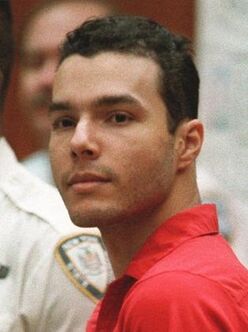
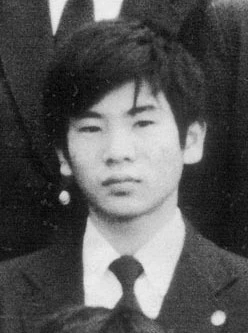
To date, there have been two infamous killers who emulated the Zodiac Killer:
- Heriberto "Eddie" Seda, a.k.a. "The New York Zodiac"
- b. July 31, 1967
- Was inspired by the Zodiac Killer
- Shot ten people, three of which died
- Targeted his victims based on their Zodiac signs
- Used zip guns
- Arrested after non-fatally shooting his half-sister in the back
- Is currently serving time in jail for murder and attempted murder
- See full article here
- "Seito Sakakibara"
- Japanese
- Fourteen years old at the time of his arrest
- Real name unrevealed due to Japanese child protection laws (though a leak revealed it is possibly Shinichirou Azuma).
- Killed a ten-year-old boy and an eleven-year-old girl
- Also claimed to have assaulted three other girls
- Wrote letters with a language similar to that of the original Zodiac
- Released after several years of imprisonment
- See full article here
Gallery of Letters
Notes
- Some believe that the Zodiac copied his symbol from a watch, whose brand was called "Zodiac". Arthur Leigh Allen, the prime suspect, received a Zodiac Sea Wolf watch as a Christmas gift not long before the murders began.
- It has also been theorized that the Zodiac was, to some extent, inspired by The Most Dangerous Game, a 1924 short story about a wealthy count, Zaroff, who traps people on his private island and hunts them in the woods for sport. A phrase from his first cipher, "...because man is the most dangerous animal of all...[sic]", supports this theory. Prime suspect Arthur Leigh Allen admitted to being a fan of the story, saying it had made an impression on him. The story can be found here.
- The Zodiac Killer has several similarities to the Phantom Killer, the unidentified perpetrator of the Texarkana Moonlight Murders of 1946. In both cases, the killer was masked, targeted couples, killed the majority of their victims by shooting them and attacked them when they were in or near their cars in lover's lanes, neither killer was caught, and they had almost identical body counts. The most obvious difference between the two is that the Zodiac wrote several taunting letters to the police and media while the Phantom did not brag about his crimes in any such way. Another is that there are no clear signs that the Zodiac was sexually motivated while the Phantom sexually assaulted a female victim with his handgun.
- The Zodiac was active around the same time and in the same state as a suspected serial killer who committed the "Astrological murders". The victims, who were women, were killed in various ways, including strangulation, drowning, throat cutting, and bludgeoning, sometimes after being drugged, and were connected by the fact that they were dumped in ravines and were killed around astrological events, such as the winter solstice, equinox, and Friday the 13th. One of the Zodiac's alleged victims, Donna Lass, was a nurse who disappeared in Lake Tahoe before the autumnal equinox and was never seen again. While law enforcement believes there is a connection between the murders, some theorize that the Zodiac may have had something to do with them.
- It was suspected that after the last letter was sent on the 29th January 1974, the Zodiac had escaped to Italy where it was believed he became the serial killer known as The Monster of Florence who was responsible for 14 murders between 1968 and 1985.
- The Zodiac case was an inspiration for the first Dirty Harry movie. The killer of that movie writes letters to the authorities and calls himself "Scorpio", a zodiac sign, and the only name he is referred to. Near the end of the movie, he takes a school bus full of children hostage, a reference to how the Zodiac threatened to kill the passengers of a school bus. In the film, Scorpio's letters were written in the same style of handwriting as the letters written by the Zodiac. Other fictional film villains inspired by the Zodiac include "The Gemini Killer" from The Exorcist III and "The Scorekeeper" from The Limbic Region. The Zodiac also seems to provide some inspiration for the character The Black Hood from the second season of the TV series Riverdale since both are killers who dress in black and write letters to the media in which they name themselves, take credit for murders and include possessions taken from victims. Also, one of the Black Hood's crimes is shooting a pair of high school students in a car, similar to the Zodiac's attack on Michael Mageau and Darlene Ferrin.
On Criminal Minds
- Season One
- "Unfinished Business" - The Zodiac is first mentioned by Reid in this episode, where the episode's unsub, Walter Kern, has his signature of sending taunting letters and puzzles to the authorities compared to the Zodiac's habit of sending letters, as well as changing their M.O. However, Reid incorrectly states the Zodiac went from stabbing his victims to shooting them. Kern may have also been based on the Zodiac - Both were serial killers who primarily targeted women (though the Zodiac Killer also killed men), used a gun at some point (the Zodiac Killer shot some of his victims, while Kern only pistol-whipped and used his to control his victims), took things from their crime scenes, and wrote taunting letters containing some sort of puzzle to the police.
- "A Real Rain" - The Zodiac was mentioned as an example of killers with an alternating victimology when it was believed the current unsub was killing his victims at random. In this reference, Gideon also incorrectly stated that the Zodiac killed for thirty years without ever getting caught.[3]
- Season Four
- "Normal" - When Norman Hill admits to his wife that he is the Road Warrior, his wife, thinking Norman is simply joking, sarcastically confesses to being the Zodiac.
- "Omnivore" - Both the Zodiac and BTK are compared to the Reaper by Hotch, who states all three were "highly intelligent, disciplined, sadistic killers who name themselves in the press". On a side note, which was possibly coincidental, both the Zodiac and Dennis Rader claimed to have fantasized about enslaving their victims in the afterlife; the Zodiac (possibly falsely) expressed this belief in his first cipher and BTK claimed during police interrogation to have had that fantasy as well. George Foyet, the aforementioned Reaper, also appears heavily inspired by the Zodiac. Like the Zodiac, he wore a black mask in his outings, his primary targets were couples, he usually either shot or stabbed his victims, and adopted a symbol (the Eye of Providence) as his "trademark". The Zodiac also threatened to kill a bus full of people, which Foyet actually does, and both also had victims who survived near-fatal attacks and provided vague descriptions of their assailants (though in Foyet's case, the attack was staged, in which he was his own victim, designed to throw the authorities off his trail). Also, Foyet's seventh victim, the only victim confirmed to be killed alone, might be an obscure reference to the Zodiac's murder of Paul Stine, his only lone victim.
- Season Seven
- "True Genius" - The Zodiac was also featured prominently in this episode, in which the unsub copies his killings with great accuracy (even wearing the same kind of hood and boots that he wore during the Lake Berryessa killings) and tries to pass himself off as the genuine killer by planting evidence such as a bloody piece of fabric (whose blood type was identical to that of Paul Stine's) and an old crime scene photo of a (fictional) suspected Zodiac victim.
- Season Eight
- "Pay It Forward" - The Zodiac was mentioned as an example of serial killers who stop killing and disappear.
- Season Ten
- "Fate" - The Zodiac was mentioned when Garcia reveals to Rossi that Joy Struthers, a true crime writer living in San Francisco, wrote a book about the killer.
- "Nelson's Sparrow" - The Zodiac was mentioned by Rossi and Gideon in a flashback set in 1978 (nine years after the Zodiac's last confirmed murder). In this reference, both mention his taunts to the police in comparison to the unsub they are investigating.
- Season Eleven
- "Tribute" - The Zodiac's police sketch was seen on the cover of the book America's Deadliest Killers, which was read by Michael Lee Peterson.
- Season Thirteen
- "Neon Terror" - The Zodiac was mentioned again.
- "Cure" - The Zodiac was mentioned again and is also likely the basis of the episode's killer, Rafael Taveras - Both are serial killers who wore dark disguises, targeted victims of both genders, attacked them at night and outside (though Taveras attacked outside when he escalated), tied them up with rope before stabbing them to death, had signatures involving leaving symbols they derived from other sources and cryptograms that got more complex with every murder, used grandiose language, made taunting phone calls to police, and gave themselves nicknames to further reinforce their crimes and presentation of them.
- Season Fifteen
- "Family Tree" - The Zodiac was mentioned by Simmons while discussing with Rossi about how Everett Lynch and other serial killers go dormant.
On Criminal Minds: Beyond Borders
- Season Two
- "Il Mostro" - The Zodiac was mentioned.
Sources
- Wikipedia:
- Zodiac by Robert Graysmith, 1986 - ISBN 0-425-09808-7
- America's Most Wanted list of known suspects
- zodiackiller.com
- CBS News report clip about Tarrance
- New York Daily News article on suspect Louis Myers
- Susan D. Mustafa's article about the Zodiac's victims
- Find A Grave article about the Zodiac's victims
- Zodiac Revisited's article about the Zodiac's suspected victims
- ALLEN: The Movie | Zodiac Killer Facts - Separating Fact & Fiction
- Zodiackiller.com
- SF Chronicle article about the solving of the 340 Cipher
- The Monster: The Zodiac Killer podcast
References
- ↑ The deaths share many characteristics of the Zodiac's confirmed murders, such as the victims being a teenage couple killed in a lover's lane and the killer forcing the female victim to tie up the male like the Zodiac did at the Lake Berryessa stabbing, though the murders haven't been officially connected to the Zodiac Killer
- ↑ Facts that connect her murder to the Zodiac are:
- Months after the murder, letters stating, "Bates had to die" were sent to local police and media. A letter stating, "She had to die" was also sent to her father. Additionally, a type-written confession using some phrases the Zodiac later used was found in the university where she had studied as well as a macabre poem scribbled into a board describing the murder in detail.
- Local investigators have good circumstantial evidence on a currently unidentified male, but he was never charged with the murder, and neither was anyone else, so the case remains unsolved. One possibility is that the unnamed man was in fact the killer and the Zodiac tried to take credit for the murder.
- A possible Zodiac link, besides the letters, was that a size 8-10 military style heel print was found on the scene along with a wristwatch that was traced to a military post, possibly in England, and whose wristband suggested that the owner had a ca. 7-inch wrist; some suspect that the Zodiac may have been English due to some of his spellings, a size 10½ military style bootprint was found at the Hartnell-Shepherd crime scene and the gloves found in Stine's cab were size 7.
- ↑ The Zodiac was confirmed to be active in 1968 and 1969, while his first suspected victims were killed in 1963 and his final suspected victim disappeared in 1970. Combining the years he was active with those of the deaths or disappearances of suspected victims (if one were to positively attribute all of them to the Zodiac), the Zodiac would've been active for only a total of seven years.


